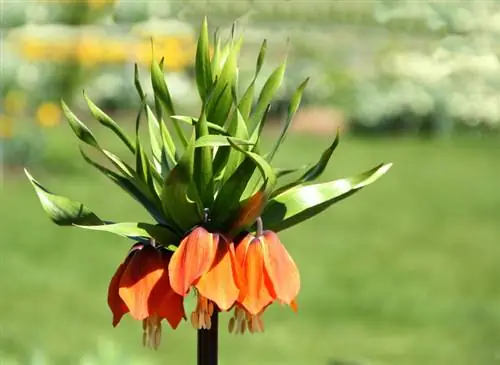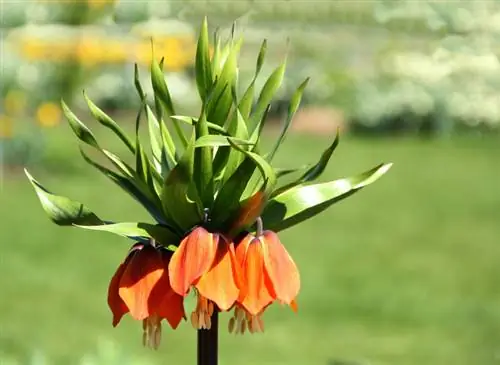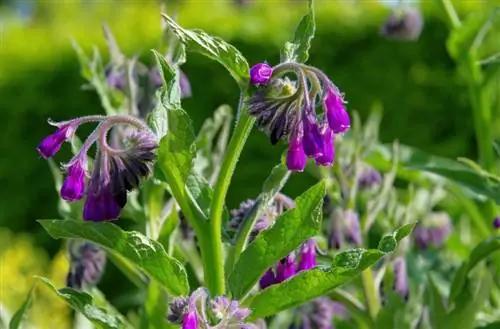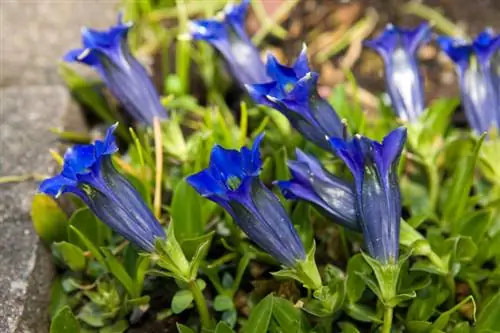- Author admin [email protected].
- Public 2023-12-16 16:46.
- Last modified 2025-01-23 11:20.
The imperial crown (Fritillaria imperialis) with its various subspecies comes mainly from Persia and certain parts of Turkey. It has been cultivated in European gardens for centuries because of its magnificent flowers and is considered an important part of biological vole defense.

How do I plant and care for an imperial crown in the garden?
Imperial crown (Fritillaria imperialis) prefers sunny or slightly shady locations with well-drained soil. Plant the bulbs between July and September, 20 to 30 cm deep and at a slight angle. Flowering time is April or May, propagation occurs by separating the bulbs.
In what form are imperial crowns available for the garden?
Specialist retailers usually sell imperial crown bulbs, as with them (in contrast to growing from seeds) you can hope for a flower with the characteristic yellow or orange calyxes the following year. If you form several specimens of the plants, which grow around one meter high, into a group, this is usually particularly visually attractive.
Which location is ideal for the imperial crown?
The imperial crown prefers locations with a lot of sunlight, but can also tolerate light shade. It is important to find a place with permeable or appropriately loosened soil, as the bulbs can easily become rotten if the soil is constantly waterlogged and then only bloom to a limited extent.
What should you consider when planting the imperial crown?
When planting the bulbs, pay attention to:
- a loose soil or a drainage layer made of sand in the planting hole
- a sufficient planting depth of around 20 to 30 centimeters
- a slight inclination of the bulbs to prevent water residue on the flattened top
Under the right conditions, imperial crowns are relatively easy to care for if they get enough water and nutrients and are not transplanted too often.
Can the imperial crown also be grown from seeds?
The imperial crown can also be grown from the seeds that form in the large seed capsules after the flowering period. However, you must not cut off the wilted inflorescences straight away, but rather wait for the seeds to ripen. Propagation by sowing is particularly interesting if you want to cross certain subspecies of the imperial crown yourself and breed your own colors.
What is the easiest way to propagate the imperial crown?
Since the young plants grown from seeds take several years to bloom for the first time, imperial crowns are usually propagated by separating the breeding bulbs that form automatically anyway. Older specimens are simply carefully dug out of the ground between July and September in order to then replant the individual bulbs in appropriately prepared planting holes.
When is the best time to plant the imperial crown?
The best time to plant the imperial crown bulbs is between July and September, as the plants' energies gradually withdraw into the bulbs after flowering in spring. Planting as early as possible allows the onions to root well in the new location before overwintering in the ground. When sowing outdoors, seeds are sown before winter or stratified accordingly, as they only enter the germination phase after a cold period.
When does the imperial crown bloom?
Depending on the location and weather, the perennial inflorescences of the imperial crown appear in April or May. These look particularly impressive in the garden bed when they are surrounded by neighbors with a slightly lower height that bloom sooner or later.
Tips & Tricks
After flowering, only the uppermost parts of the withering flower stalks on the imperial crowns should be removed. Leave the lower parts with the leaves standing until they wilt on their own. This allows the plants to store maximum energy in the bulbs for the next growing season.






